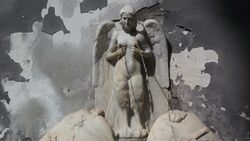Religion:Parthenope (Siren)
The Fountain of the Spinacorona, a depiction of Parthenope in Naples. | |
| Grouping | Mythological |
|---|---|
| Sub grouping | Siren |
| Family | Child of Achelous and Terpsichore |
| Folklore | Greek |
| Country | Greece |
| Region | Sirenum scopuli |
Parthenope (Ancient Greek:) was one of the Sirens in Greek mythology.[1][2][3][4] Her name means "maiden-voiced" from parthenos and ops.[5]:20
Family
Parthenope was the daughter of the god Achelous and the Muse Terpsichore.[5]:35[6] Her two sisters were called Ligeia, and Leucosia.[4][2][7][8]
Mythology
According to Greek legend, Parthenope cast herself into the sea and drowned when her songs failed to entice Odysseus.[9][10]:293 Her body washed ashore at Naples, on the island of Megaride, where the Castel dell'Ovo is now located.[11] Her tomb on the island was called "constraction of sirens".[12] When people from the city of Cumae settled there, they named their city Parthenope in her honour.[13]
A Roman myth tells a different version of the tale, in which a centaur named Vesuvius was enamored with Parthenope. Angered, Jupiter turned the centaur into a stratovolcano and Parthenope into the city of Naples. Thwarted in his desire, Vesuvius' rage is manifested in the volcano's frequent violent eruptions.[14]
In literature and art
Parthenope has been depicted in various forms of literature and art, from ancient coins that bore her semblance[6] to the Fountain of the Spinacorona, where she is depicted quenching the fires of Vesuvius with water from her breasts.[15] In his Georgics, Virgil stated that he had been nurtured by Parthenope, writing:
At that time sweet Parthenope was nurturing me, Virgil, as I flourished in the pursuits of my inglorious leisure...—Virgil, Georgics[10]:289
In addition, Parthenope has served as the inspiration for a number of other works, such as Manuel de Zumaya's Partenope and the ancient Greek novel Mētiokhos kai Parthenopē.[16] Also, several operas based on the myth of Parthenope were composed on the 18th century by Sarro (1722), Vinci (1725), Handel (1730), Vivaldi (1738) and Hasse (1767). The poem An Afternoon in Naples at the Time of Bomba by Herman Melville cites Parthenope as a source of Naples' mythological identity.[17]
Notes
- ↑ Lycophron, Alexandra 720
- ↑ 2.0 2.1 Eustathius, l.c. cit.; Strabo, Geographica 5.246, 252
- ↑ Servius, Commentary on Virgil, Georgics 4.562
- ↑ 4.0 4.1 Tzetzes, Chiliades 1.14, line 337 & 6.40
- ↑ 5.0 5.1 Austern, Linda; Naroditskaya, Inna, eds (2006). Music of the Sirens. Bloomington, Indiana: Indiana University Press. ISBN 0-253-21846-2. https://books.google.com/books?id=5IBSGG9YegwC&dq=Parthenope+siren&pg=PT29. Retrieved 28 June 2014.
- ↑ 6.0 6.1 Spink & Son (1906). The Numismatic Circular and Catalogue of Coins, Tokens, Commemorative & War Medals, Books & Cabinets, Volume 14. Piccadily: Spink & Son. p. 9010. https://books.google.com/books?id=5spLAAAAYAAJ&dq=Parthenope+siren&pg=RA2-PA160. Retrieved 28 June 2014.
- ↑ Lycophron, Alexandra 720-726
- ↑ Servius commentary on Virgil, Georgics 4.562
- ↑ Facaros, Dana; Pauls, Michael (2007). Bay of Naples and Southern Italy. Cape Town, South Africa: New Holland Publishers. p. 21. ISBN 978-1-86-011349-9. https://books.google.com/books?id=tNwg7eWUFL4C&dq=parthenope+odysseus&pg=PA21. Retrieved 29 June 2014.[yes|permanent dead link|dead link}}]
- ↑ 10.0 10.1 Miles, Gary B. (1980). Virgil's Georgics: A New Interpretation. Berkeley and Los Angeles: University of California Press. p. 293. ISBN 0-520-03789-8. https://archive.org/details/virgilsgeorgicsn0000mile. Retrieved 29 June 2014. "parthenope odysseus."
- ↑ Lancaster, Jordan (2005). In the Shadow of Vesuvius: A Cultural History of Naples. London and New York: I.B. Tauris. p. 11. ISBN 1-85043-764-5. https://books.google.com/books?id=TnM1g0oKkN0C&dq=parthenope+megaride&pg=PA11. Retrieved 30 June 2014.
- ↑ Lycophron, Alexandra 716
- ↑ Jansen, Laura, ed (2014). The Roman Paratext: Frame, Texts, Readers. Cambridge UK: Cambridge University Press. p. 230. ISBN 978-1-107-02436-6. https://books.google.com/books?id=iXM9AwAAQBAJ&dq=Parthenope+siren&pg=PA230. Retrieved 30 June 2014.
- ↑ Ledeen, Michael (2011). Virgil's Golden Egg and Other Neapolitan Miracles: an Investigation into the Sources of Creativity. New Brunswick, New Jersey: Transaction Publishers. p. 37. ISBN 978-1-4128-4240-2. https://books.google.com/books?id=KtufeoUMNBoC&dq=parthenope+odysseus&pg=PA37. Retrieved 30 June 2014.
- ↑ "Fontana di Spinacorona (detta Fontana delle zizze)". http://www.corpodinapoli.it/ospitalita/monumenti/fontana-spinacorona.html.
- ↑ Hägg, Thomas; Utas, Bo, eds (2003). The Virgin and Her Lover: Fragments of an Ancient Greek Novel and a Persian Epic Poem. Leiden, Netherlands: Brill Publishers. p. 5. ISBN 90-04-13260-0. https://books.google.com/books?id=H2KiFE71wJIC&dq=Parthenope+siren&pg=PA49. Retrieved 30 June 2014.
- ↑ Cook, Jonathon (2022). ""A Medley Mad of Each Extreme": Melville's "An Afternoon in Naples in the Time of Bomba" as Moral Quest". https://www.proquest.com/docview/2813534240.
References
- John Tzetzes, Book of Histories, Book I translated by Ana Untila from the original Greek of T. Kiessling's edition of 1826. Online version at theio.com
- Lycophron, The Alexandra translated by Alexander William Mair. Loeb Classical Library Volume 129. London: William Heinemann, 1921. Online version at the Topos Text Project.
- Lycophron, Alexandra translated by A.W. Mair. London: William Heinemann; New York: G.P. Putnam's Sons. 1921. Greek text available at the Perseus Digital Library.
- Strabo, The Geography of Strabo. Edition by H.L. Jones. Cambridge, Mass.: Harvard University Press; London: William Heinemann, Ltd. 1924. Online version at the Perseus Digital Library.
- Strabo, Geographica edited by A. Meineke. Leipzig: Teubner. 1877. Greek text available at the Perseus Digital Library.
 |



